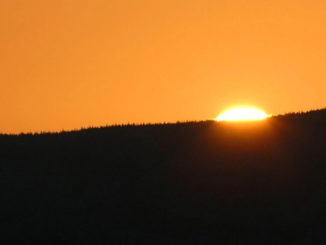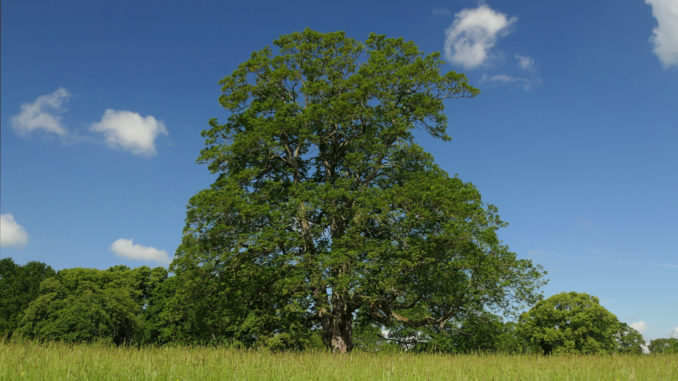
© DMG 2021, Going Postal 2021
Litha
Litha is the name given to the summer solstice. While the rest of the sabbats that make up the Wheel of the Year have reasonably secure roots in past beliefs and traditions, ‘Litha’ has a far weaker pedigree.
Ancient people all around the world have marked the longest day for a long time, but there seems to be a dearth of specific information about what they did, never mind why they did it. What we do know is that in the absence of fireworks or laser light shows, fire was naturally very popular. No doubt there was dancing around the fire, while animals and crops were blessed. It seems the usual connections existed between these fires and driving out evil spirits, while simultaneously bringing fertility and prosperity to the community. And as with other summer fire festivals, the scattering of ashes on the fields helped ensure a strong harvest. The weather was good, and with life in limbo — between the crops being planted, but not yet ready for harvest — community gatherings and social events were important.
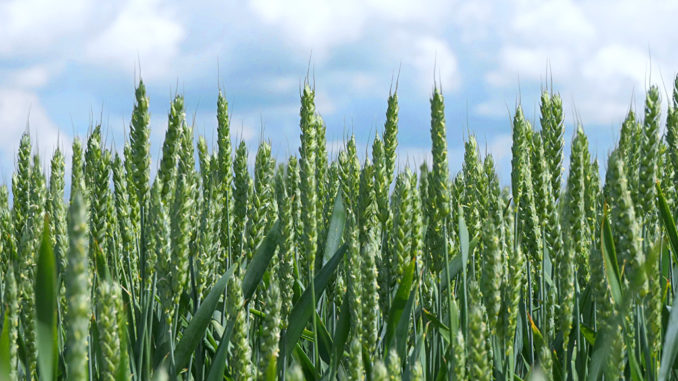
© DMG 2021, Going Postal 2021
Many traditions include lighting bonfires in various locations atop hills, and next to sacred wells and other important locations. The Celts would supposedly light fires all around their lands from sunset the night before midsummer. Jacob Grimm noted that there were two points in the summer calendar when people lit bonfires. The northern people lit them at Ostara, and the southern people lit them at midsummer, but he believed that the Ostara fires were a much older tradition.
Regardless, hilltop bonfires were recorded by early monks. No one really knows if they were trying to bridge heaven and Earth (a motivation commonly attributed to the Celts and Druids), or if they were simply mimicking the sun being at its highest by building their fire as high as they could. No doubt an element of competitiveness crept into neighbouring settlements, with smug declarations of, “our fire’s higher than your fire!”
Spectacularly upping the ante from simply having a bonfire or two, some communities would set alight either a huge wooden wheel or a barrel of tar and roll it down a hill. The wheels were likely packed with straw to keep it burning, and sometimes it was intended to end its brief journey in a river. Sadly, while this sounds like a far more exciting way to celebrate, it doesn’t sound like it was as widespread as I would have liked.
Various — and often contradictory — superstitions were attached to this practice. In the Vale of Glamorgan, a cartwheel was rolled down the hill, and if it kept burning all the way down, an abundant harvest should be expected. Yet other Welsh beliefs say that a good harvest was on the cards if the fire went out before the wheel reached the river.
In the 13th century, the monk of Winchcomb, Gloucestershire, helpfully notes down an explanation for the old burning wheel party trick, telling us “The wheel is rolled to signify that the sun then rises to the highest point of its circle and at once turns back; thence it comes that the wheel is rolled.” He also noted that boys would collect bones and other assorted rubbish to burn, as well as making burning brands and roaming around with them.
There is an interesting idea relating to fire wheels and Serbian gods though. While the solstice marks the sun’s highest position in the sky, the climatic seasons lag behind the solar calendar, with the period between the solstice and the beginning of August as the hottest part of the year. In Serbia the ‘thundering god’ (St Ilija) gets so angry he intends to burn the whole world down, but is thankfully calmed down by his wife, ‘fiery Mary’ (Ognjena Marija). Summer ends with the advent of the Slavic storm god, Perun. This represents the hot days of summer drought and wildfires giving way to Autumn rains. The first part of August 2nd is summer, and the second part of the same day is Autumn.
The burning wheel fits beautifully with this local symbology, as the fiery wheel burns in increasing intensity, rushing headlong down the hillside, before being doused in a river. This has clear echoes of the days getting hotter and hotter following the sun’s maximum ascendancy—before the onset of autumn rains. Or perhaps older beliefs and traditions have simply entwined over the centuries and grown to fit each other.
For their part, the Norse can never resist the opportunity to have a firelit procession involving the whole community, including their herds. Firelit processions weren’t exclusive to Nordic cultures though. As solstice celebrations became more and more rowdy in this country, watchmen attempted to contain them, until in 1378 they joined forces as the aldermen in London hired a number of watchmen to act as bodyguards for the procession. They ended up walking behind the aldermen, carrying flaming pails atop poles, and thus continued a tradition of carrying fire around the village. Successive Lord Mayors attempted to outdo previous events, and the processions became more impressive as the years passed. Naturally, other towns and cities followed suit.
It is tricky to date any of the common festivities associated with midsummer. I don’t think it’s unreasonable to accept the fire festivals are ancient, as they tie in with the other (better understood) pre-Christian festivals. Also, there are records of Christians getting grumpy about older rituals being continued. In the 7th century, Saint Eligius didn’t want his recent converts to partake in their usual celebrations, and he reportedly told them: “No Christian on the feast of Saint John or the solemnity of any other saint performs solestitia (summer solstice rites) or dancing or leaping or diabolical chants.” Like many other traditions, these midsummer shenanigans appear to be something early Christianity begrudgingly tolerated, rather than promoted.
The timing of these celebrations should be reasonably straightforward — all that is required is to mark the summer solstice, the three-day period when the sun reaches its greatest height in the sky. But as usual, when you scratch the surface, you realise that, as usual, there is fair scope for personal interpretation. The most logical time to mark it would be on the actual solstice, which falls on June 21st (most of the time). But then, following the standard Celtic practice of a new day starting at sunset, a strong case can be made that we should really be celebrating at sunset on the 20th.
And to further muddy the waters, because of various astronomical wobbles and changing calendars, way back in Roman times the solstice actually took place on the 24th. Since then however, other meaning has been pinned to that date, and now it appears to be too much hassle to restore ‘Midsummer’s Day’ back to where it rightfully belongs — on midsummer. And of course, just for variety, some celebrate on the eve of the 23rd for the same reasons mentioned above. It’s not uncommon for some to stay up all night, observing sunset on Midsummer’s Eve, and then the following sunrise.
A strong link to magic exists around this time, which likely has links to the fact that most wild herbs are fully mature around this time. Medicinal plants would have been gathered to dry and store, which explains a Welsh tradition of referring to Midsummer Day as Gathering Day. These deeply ingrained connections between midsummer and mischievous magical folk were a seam richly mined by Shakespeare.
As well as casting herbs into the fires, St John’s wort was popular for keeping the faery folk at bay, as well as divination in matters of marriage. And speaking of marriage, midsummer was a popular time to renew vows and formalise handfasting’s from the previous year’s Beltane.
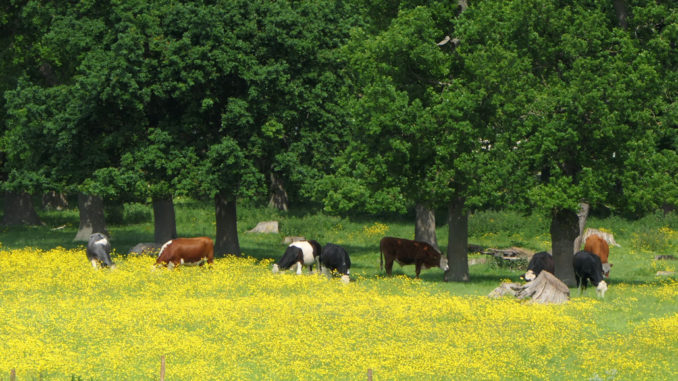
© DMG 2021, Going Postal 2021
In terms of the dual nature of the seasons, the Oak King is at the height of his power, which may account for the added significance of oak at this time of the year. The Celtic word for oak is ‘Duir’, which also means ‘door’ or ‘doorway’, as well as being the origin of the word Druid. Often overlooked, however, is that the Oak King’s counterpart, the Holly King — the ruler of the dark months — is reborn today, indicating that from here on in, the days start to grow shorter again. Even this isn’t clear-cut though, as traditions vary, and some have the Oak King killed in battle by the Holly King at the solstice.
As you can probably tell, ancient beliefs in Britain tended to be very localised, and there was no universally celebrated religion. While the most recognised gods are usually Northern European, the ancient Britons were no doubt influenced by the same universal themes and principles, which were adapted by each community and evolved as their needs changed. However, something which seems to have been constant was the ancient’s interest in tracking the seasons through the movements of the sun. This seems a fair conclusion based on the incredible amount of time and effort they put into creating huge stone monuments.
Stonehenge was started around five-and-a-half thousand years ago but was constructed in stages over a period of one-and-a-half to two thousand years. The builders had no written language, and so the function of the monument must have been so deeply ingrained in their core beliefs that even after two thousand years those working on it understood what those who started it were aiming for. A truly impressive feat, considering I have seen projects which lose sight of their initial goals and fall apart after a month or two.
Interestingly, even though it was built thousands of years before the Celts (who later became the Druids) arrived on the scene, the stones are aligned to the eve of the winter solstice, matching the Celtic method of marking the end and beginning of days at sunset. This suggests that elements of Celtic culture are drawn from older beliefs.
Amusingly, the same logic quite likely applies for the summer solstice. In 2015, a steward at the site, Tim Daw, discovered that the tallest stone points to the midsummer sunset. He identified an alignment of stones and predicted that the sun would set along the back of a particular stone on Midsummer’s Eve. He was spot on. This reinforces other archaeological theories which suggest that the midsummer sunrise alignment with the heelstone is far less significant than previously thought.
I wonder if it’s ever occurred to the thousands of folk swarming over the ancient site, waiting for the sunrise, that they might be missing the intended moment by seven-and-a-half hours.
Regardless, judging by the archaeological evidence, it’s likely that the monument was never intended to be the site of a huge celebration, and it was far more than a glorified sundial. We know the site served as a burial ground before the Stonehenge we recognise was built. It served as a graveyard, a memorial to the dead, and was the site of formalised rituals, probably quite sombre affairs. The parties seemed to have been held a short walk away at Durrington Walls, which is where the Neolithic equivalent of crushed beer cans and half-eaten pizza has been found. Those who built and used Stonehenge would quite likely be horrified by what goes on there now.
Not quite as ambitious, but still impressive, is Castlerigg stone circle near Keswick.
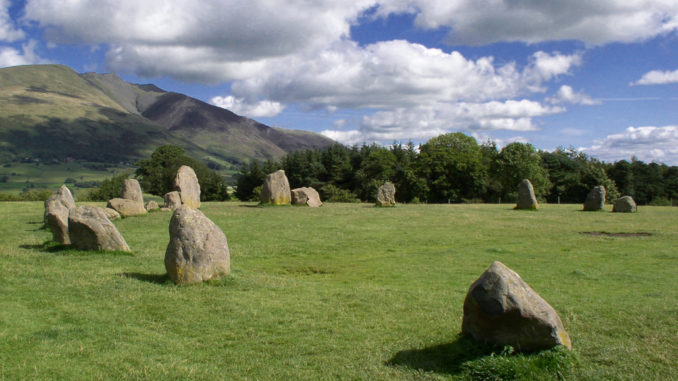
© DMG 2021, Going Postal 2021
Professor Alexander Thom concluded that it was an astronomical observatory, and that the builders worked hard to incorporate the features of the landscape into their work. As the site is on a gentle slope, at sunset on midsummer’s day, the largest stone casts a shadow nearly half a mile long.
Researcher John Glover observed that: “One of the four alignments defined by the construction lines of the circle reveals the feat of indicating two solar events in the Neolithic calendar at opposite ends of the alignment.; the midsummer setting sun and the Candlemas rising sun. This is made possible by the geometry. Astoundingly, the builders have made use of another natural feature along this alignment.
At midsummer’s day, the sun appears to set at an angle formed by the large stone of the alignment and the ridge of Latrigg away to the west. The exact point of the sunset appears to have been marked by one of the mounds on that ridge.”
They may have lived thousands of years ago, but these people were certainly not stupid by any stretch of the imagination.
So where does the term ‘Litha’ come into things? It is sometimes claimed that the term is the original name for this particular festival, but there’s no evidence to support this assertion. The most amusing claim I have read is that the term was invented by Lord of the Rings author J.R.R. Tolkien. In the (excessively extensive) appendices to his epic work, the calendar used by Hobbits refers to Summer’s Day as Lithe.
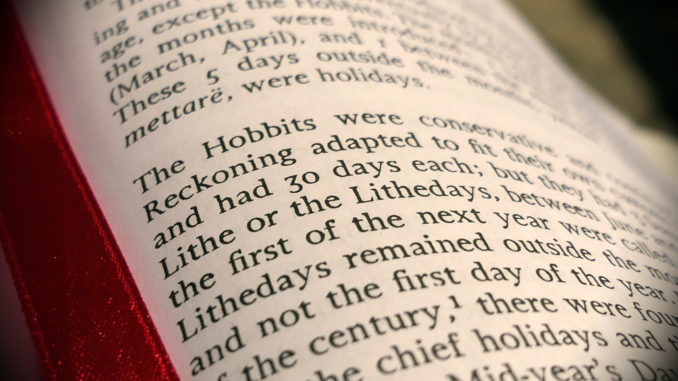
© DMG 2021, Going Postal 2021
But this claim is also nonsense. Among his vast literary experience, he was the Rawlinson and Bosworth Professor of Anglo-Saxon, so would have been intimately familiar with Bede’s writings. In De Temporum Ratione, Bede records Anglo-Saxon names for the months of June and July as Ærra Liþa and Æfterra Liþa, which correspond to ‘early Litha month’ and ‘later Litha month’. It is a safe bet that in creating his rich fantasy world, Tolkien lifted familiar historical elements to echo our actual past.
So, what about the etymology of the word ‘Litha’? Does the word come from some ancient festival or belief that the Anglo Saxons inherited? The simple answer is ‘no’. Litha meant ‘pleasant’ or ‘navigable’, referring to the summer months when visibility was better, and waters were calmer, thus making sailing safer and easier. So Litha only designates the summer months in a roundabout sort of way, and certainly not just for the three days of the solstice.
So how on earth did the name Litha become associated with the Solstice? Well, you may recall that the festivals which are now central to neopagans and wiccans were rebranded (and in some cases tweaked) in the 1950s by Ross Nicholls and Gerard Gardner to make up their ‘Wheel of the Year’.
Gardner was central to the establishment of modern wicca, and was in turn, building on the work of Margaret Murray, who had authored The Witch-Cult in Western Europe.
Murray claimed that through careful reading of the transcripts of the witch trials, it was possible to understand the beliefs of a secret, surviving branch of witchcraft. Among other things, she wrote about the fire festivals celebrated by the Druids.
She was a leading Egyptologist, and she commanded such respect in this field, that most fellow historians politely waited until after her death before ripping her theory about a surviving cult of witches to pieces. But by then, her ideas had gained popularity.
Gardner claimed to have met with this branch of witches, and it seems that Litha becoming part of the Wheel of the Year was a compromise between Gardner and Nichols — who was the head of the Order of Bards, Ovates and Druids.
So that’s a quick tour through what ‘Litha’ is about. Or more plainly, ‘midsummer’ or simply ‘the summer solstice’.
I feel that celebrating it in my preferred way — setting fire to something and pushing it off somewhere high up —would be frowned upon these days, so now I like to consider it as ‘the lunch hour of the year’. You’ve made a solid start, and there’s not a lot more you can do right now. It’s the perfect time to take a breather before the hard work begins again when you need to harvest your efforts before the end of the cycle.
Next up: The harvest begins at Lughnasadh!
© Carvetii 2021
The Goodnight Vienna Audio file


